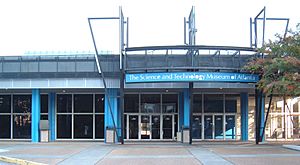SciTrek facts for kids
| Science & Technology Museum of Atlanta | |

Museum entrance
|
|
| Lua error in Module:Location_map at line 420: attempt to index field 'wikibase' (a nil value). | |
| Established | October 29, 1988 |
|---|---|
| Dissolved | August 27, 2004 |
| Location | 395 Piedmont Avenue North East Atlanta, Georgia 30308 USA |
| Type | Children's Science & Technology Museum |
| Collection size | 140 exhibits appealing to all age ranges |
The Science & Technology Museum of Atlanta, known as SciTrek, was a cool place in Atlanta, Georgia. It was located on Piedmont Avenue, right next to the Atlanta Civic Center. SciTrek was a special museum where kids and families could explore science and technology. It was open for many years, from 1988 until 2004. Sadly, it closed because it didn't have enough money to keep going.
Contents
The Story of SciTrek
How SciTrek Began
The idea for SciTrek started in 1982. Two friends, Mary O'Connor and Sue Trotter, wanted to create a science museum for Atlanta. They were part of a group called the Junior League.
SciTrek officially became a non-profit organization in 1982. A non-profit group uses its money to help people or a cause, not to make a profit. They received an early grant from the Metropolitan Foundation. The city of Atlanta also helped by giving the museum a large space inside the Atlanta Civic Center.
The Robert W. Woodruff Foundation donated $1 million to the project. After lots of planning and raising money, SciTrek finally opened its doors. The grand opening was on October 29, 1988.
SciTrek's Busy Years
When SciTrek first opened, it had 34 staff members and 150 volunteers. Its yearly budget was $2.5 million. During its first three days, 11,000 people visited the museum! By the end of its first year, SciTrek had welcomed 350,000 visitors. The people who ran the museum hoped that one day, a million people would visit each year.
In 1991, SciTrek saw more than 750,000 visitors. Most of these visitors were schoolchildren. In 1997, Gwen Crider became the new president and executive director. She used to work at the Smithsonian Institution's National Air and Space Museum. In 2001, Good Housekeeping magazine even named SciTrek one of the top 10 science museums in the country.
Even with fewer visitors between 1993 and 1999, SciTrek managed to pay off a $3 million debt in 1999. In 2000, Lewis A. Massey, who used to be Georgia's secretary of state, became the new president and CEO.
Challenges and Closure
By early 2001, SciTrek was facing serious money problems. It was losing a lot of money each month. The museum had been in debt for three years. The board gave SciTrek 90 days to try and fix things. The State of Georgia, which usually gave SciTrek $175,000 a year, added another $300,000 to help. In 2002, the Georgia Assembly gave SciTrek $425,000 and started a campaign to raise $5 million.
In January 2003, a new and exciting exhibit opened: the Challenger Learning Center. It was a $1.7 million simulation of a space shuttle mission. Later that year, Scott Coleman became the new president and CEO. However, in June 2003, the Georgia Department of Education cut SciTrek's funding by 10 percent.
Because of these funding cuts from the state and federal government, SciTrek had to close its doors in August 2004. All of its exhibits were sold or auctioned off in January 2005. Some parts, like the Challenger Learning Center, were moved to the Fernbank Science Center in Atlanta. SciTrek's name and educational materials were given to Valdosta State University in 2005. This new SciTrek now helps teachers and students in South Georgia.
Amazing Exhibits
SciTrek had over 140 interactive exhibits that were fun for all ages. These displays let visitors explore and discover the wonders of science.
- KidSpace: There was a special area called KidSpace just for younger children, aged 2 to 7. It was designed to be a safe and exciting place for them to learn.
- Mathematica: An exhibit called Mathematica: A World of Numbers... and Beyond showed important moments in the history of mathematics. It also explained cool math ideas like Kepler's laws of planetary motion (how planets move) and probability theory (the chance of something happening).
- Energy and Light: Other exhibits focused on how electricity is made in surprising ways. You could learn about creating energy from magnetism, "freezing shadows," or even stepping inside a giant kaleidoscope.
Special Programs
Challenger Learning Center
SciTrek's Challenger Learning Center was a super cool, realistic simulation of a NASA space shuttle mission. It cost $1.7 million and opened in January 2003. When SciTrek closed, the Challenger Learning Center was going to be sold. Many museums wanted it, but none could afford the $1.7 million price tag. It almost ended up in the scrap yard!
Luckily, Turner Broadcasting System stepped in and raised the money to buy it. They then donated it to Atlanta's Fernbank Science Center, where it continues to inspire young astronauts today.
STARS: Amateur Radio Station
SciTrek also had a special amateur radio station called W4WOW, run by the STARS group (SciTrek Amateur Radio Society). Amateur radio, often called "ham radio," lets people talk to others around the world using radio waves.
The STARS group used different types of radio signals and frequencies. They often used HF, UHF, and VHF bands. When the museum was open, the group met once a month at the radio station.
Tech High School
In August 2004, a new charter school called Tech High opened inside the same building that SciTrek used to be in. A charter school is a public school that operates independently.



